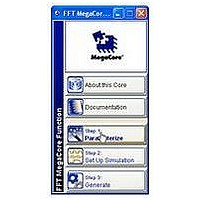IPR-FFT Altera, IPR-FFT Datasheet - Page 56

IPR-FFT
Manufacturer Part Number
IPR-FFT
Description
IP CORE Renewal Of IP-FFT
Manufacturer
Altera
Type
MegaCorer
Specifications of IPR-FFT
Software Application
IP CORE, DSP Filters And Transforms
Supported Families
Arria GX, Cyclone, HardCopy, Stratix
Features
Bit-Accurate MATLAB Models, Radix-4 And Mixed Radix-4/2 Implementations
Core Architecture
FPGA
Core Sub-architecture
Arria, Cyclone, Stratix
Rohs Compliant
NA
Function
Fast Fourier Transform Processor
License
Renewal License
Lead Free Status / RoHS Status
na
Lead Free Status / RoHS Status
na
A–4
Figure A–1. Scaling of Input Data Sample = 5000H
Achieving Unity Gain in an IFFT+FFT Pair
FFT MegaCore Function User Guide
Given sufficiently high precision, such as with floating-point arithmetic, it is
theoretically possible to obtain unity gain when an IFFT and FFT are cascaded.
However, in BFP arithmetic, special attention must be paid to the exponent values of
the IFFT/FFT blocks to achieve the unity gain. This section explains the steps required
to derive a unity gain output from an Altera IFFT/FFT MegaCore pair, using BFP
arithmetic.
Because BFP arithmetic does not provide an input for the exponent, you must keep
track of the exponent from the IFFT block if you are feeding the output to the FFT
block immediately thereafter and divide by N at the end to acquire the original signal
magnitude.
Figure A–2 on page A–5
equation to achieve unity gain.
shows the operation of IFFT followed by FFT and derives the
Appendix A: Block Floating Point Scaling
Achieving Unity Gain in an IFFT+FFT Pair
© December 2010 Altera Corporation















